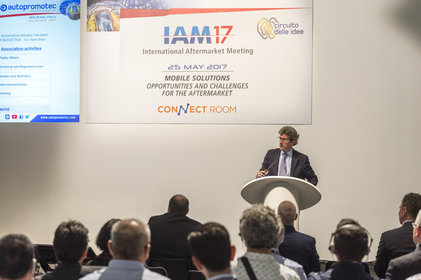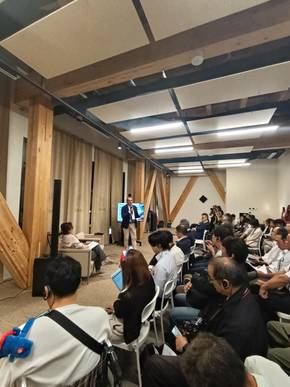
21/06/2017
Aftermarket, in order to face the "mobile" revolution the sector must rethink its business model. Here are some examples
Editorial Staff
At Autopromotec 2017, entrepreneurs and industry experts debated, during the International Aftermarket Meeting, over which strategies must be adopted to revamp the after-sales service segment. Hyper-technological and hyper-connected vehicles require increasingly qualified specialists and cutting-edge tools to cater to new customer needs.
The automotive sector is rapidly evolving and the aftermarket segment is now called upon to redefine its business model if it wants to survive. In fact, as Hyper-technological vehicles invade our roads and car-sharing schemes become increasingly popular, after-sales operators have no other option but to improve their products and offers so as to cater to the needs of customers and their hyper-connected vehicles. Entrepreneurs and experts met at Autopromotec 2017 to talk about these and other issues during the 2017 International Aftermarket Meeting.
Aftermarket figures
Aftermarket data show a 3.6% decline, after a 4.3% growth in 2015. These numbers though, as illustrated by Gianmarco Giorda, director of Anfia (the National Association of the Automotive Industry) should not cause any alarm. "These figures depict a typical industrial cycle - explains Giorda. If we take a look at production figures and new vehicle registrations, Italy is currently experiencing an upturn and this year we will probably pass the 2 million new registrations mark. Feelings are therefore quite positive for the future". Marc Aguettaz, managing director of GiPA, supplied a few more specific data. His analysis started by looking at the total number of cars circulating in Italy as well as the average age of the vehicles. In 2016 the number of vehicles circulating throughout the country was over 32 million, a positive element indeed. The downside of this relates to the age of the vehicles considered: in 2017 only 16% out of the total number of cars are less than 3 years old, while those averaging over 15 years have gone from 9% in 2007 to 18%, with an annual mileage that has remained substantially the same - 12,676 kilometers per annum – a 3,5% increase.
Today, there are 53,229 car specialists, 75,3% of which fall within the Iam network, while 24,7% belong to Oem networks, with the latter being the ones who paid the highest price during the recession, with official dealers suffering the most from dwindling profit margins. The percentage of vehicles entering workshops for routine preventive maintenance dropped to 37% in 2013-2014, followed by a 41% rise last year while normal maintenance operations scored 59%. Vehicles entering workshops declined from 1.9% in 2007 to 1.7 last year. In the aftermath of the economic crisis a great number of motorists decided to postpone repair and maintenance work on their vehicles, and as a result workshops ordered fewer spare parts. A trend meant to stop, fortunately. And the evidence of this is a spare parts sales recovery which totaled 5.2 million euro in 2016. "Basically, we can safely say that 70% of the cars that will be circulating in 2022 has already been registered today - concludes Aguettaz – and the last few years have been very been positive for the aftermarket, with 61% of its turnover in the hands of independent workshops and networks. But this means that also the big players in the industry have grown and only those able to meet the challenges of the future will come out on top”.
Sharing mobility and the internet of things
According to Tim Armstrong, vice president of Ihs Automotive’s Planning Solutions, what we are experiencing "is a second revolution in the automotive industry. We are going - he says - from cars considered as products to mobility viewed as a service". New companies are entering this sector (just think of Uber or Didi) forcing the entire industry to rethink services such as on-demand transport service, which is the one with the most interesting propositions. Yet this process is not taking place with the same pace around the world. "Emerging markets can boast 35% of active users in this service sector against the mere 10% in more mature markets", continues Armstrong. "Success in the future will no longer be measured by the number of cars sold but by the number of kilometers traveled", he continues. "Today, the taxi market in the US is worth $ 5-6 billion against the $ 600 billion in new car sales. But by 2040 car-sharing schemes could account for as much as 22% of the total transport costs". Furthermore, new rules and regulations are favoring the spread of electric vehicles, which will progressively cut costs and be less demanding in maintenance. "The way assistance and services are supplied must also change - says the expert – turning into a mileage-based service, as is already the case for transport vehicles". Matthias Knirsch, director of business development at Bosch Automotive Aftermarket, focused on the pivotal role played by connectivity systems on single vehicles as well as the entire after sales segment, illustrating some of the systems developed by his company to manage the Internet of things and vehicle connectivity. "In the future, the whole system will be connected, the vehicle of the future will become part of the web through smart systems that will integrate a variety of services. This - he continues - entails opportunities but also risks for some of the main players, whether manufacturer or distributor, not to mention workshops". Then there is also a problem with data protection: "The customer must be able to decide what information to give out and to whom. At Bosch, we have developed encryption systems able to secure this information from hacker attacks".
A new business model driven by innovation
TomTom, on the other hand, shows how a company can re-invent itself to meet the changing needs of the market. "Many predicted that with the advent of mobile phones or Google Maps, TomTom would have disappeared - says Sebastian Ruffino, TomTom Bridge business unit manager - but we are still here shaping the industry". Among the examples mentioned we find a system adopted by the London Fire Department able to direct firefighters towards emergencies with all the necessary data for their work, dedicated devices on German ambulances or other types of devices for site vehicles. "Connected mobility is a reality, and we must turn risks into opportunities," concludes Ruffino. "Everything is moving much faster than we had expected," adds Fotios Katsardis, president and CEO of Temot International, a German aftermarket giant. "In 2000 we estimated that 65% of wholesalers would have been part of a network while today we are looking at 75%. We did not give too much importance to e-commerce and we all know what kind of development it has had. Whatever we present or unveil today will soon become obsolete - he continues – which justifies a measure of euphoria in the industry looking at the enormous potentials, but we still expect a perfect storm. The aftermarket has to redefine its business model if it wants to survive".
Aftermarket figures
Aftermarket data show a 3.6% decline, after a 4.3% growth in 2015. These numbers though, as illustrated by Gianmarco Giorda, director of Anfia (the National Association of the Automotive Industry) should not cause any alarm. "These figures depict a typical industrial cycle - explains Giorda. If we take a look at production figures and new vehicle registrations, Italy is currently experiencing an upturn and this year we will probably pass the 2 million new registrations mark. Feelings are therefore quite positive for the future". Marc Aguettaz, managing director of GiPA, supplied a few more specific data. His analysis started by looking at the total number of cars circulating in Italy as well as the average age of the vehicles. In 2016 the number of vehicles circulating throughout the country was over 32 million, a positive element indeed. The downside of this relates to the age of the vehicles considered: in 2017 only 16% out of the total number of cars are less than 3 years old, while those averaging over 15 years have gone from 9% in 2007 to 18%, with an annual mileage that has remained substantially the same - 12,676 kilometers per annum – a 3,5% increase.
Today, there are 53,229 car specialists, 75,3% of which fall within the Iam network, while 24,7% belong to Oem networks, with the latter being the ones who paid the highest price during the recession, with official dealers suffering the most from dwindling profit margins. The percentage of vehicles entering workshops for routine preventive maintenance dropped to 37% in 2013-2014, followed by a 41% rise last year while normal maintenance operations scored 59%. Vehicles entering workshops declined from 1.9% in 2007 to 1.7 last year. In the aftermath of the economic crisis a great number of motorists decided to postpone repair and maintenance work on their vehicles, and as a result workshops ordered fewer spare parts. A trend meant to stop, fortunately. And the evidence of this is a spare parts sales recovery which totaled 5.2 million euro in 2016. "Basically, we can safely say that 70% of the cars that will be circulating in 2022 has already been registered today - concludes Aguettaz – and the last few years have been very been positive for the aftermarket, with 61% of its turnover in the hands of independent workshops and networks. But this means that also the big players in the industry have grown and only those able to meet the challenges of the future will come out on top”.
Sharing mobility and the internet of things
According to Tim Armstrong, vice president of Ihs Automotive’s Planning Solutions, what we are experiencing "is a second revolution in the automotive industry. We are going - he says - from cars considered as products to mobility viewed as a service". New companies are entering this sector (just think of Uber or Didi) forcing the entire industry to rethink services such as on-demand transport service, which is the one with the most interesting propositions. Yet this process is not taking place with the same pace around the world. "Emerging markets can boast 35% of active users in this service sector against the mere 10% in more mature markets", continues Armstrong. "Success in the future will no longer be measured by the number of cars sold but by the number of kilometers traveled", he continues. "Today, the taxi market in the US is worth $ 5-6 billion against the $ 600 billion in new car sales. But by 2040 car-sharing schemes could account for as much as 22% of the total transport costs". Furthermore, new rules and regulations are favoring the spread of electric vehicles, which will progressively cut costs and be less demanding in maintenance. "The way assistance and services are supplied must also change - says the expert – turning into a mileage-based service, as is already the case for transport vehicles". Matthias Knirsch, director of business development at Bosch Automotive Aftermarket, focused on the pivotal role played by connectivity systems on single vehicles as well as the entire after sales segment, illustrating some of the systems developed by his company to manage the Internet of things and vehicle connectivity. "In the future, the whole system will be connected, the vehicle of the future will become part of the web through smart systems that will integrate a variety of services. This - he continues - entails opportunities but also risks for some of the main players, whether manufacturer or distributor, not to mention workshops". Then there is also a problem with data protection: "The customer must be able to decide what information to give out and to whom. At Bosch, we have developed encryption systems able to secure this information from hacker attacks".
A new business model driven by innovation
TomTom, on the other hand, shows how a company can re-invent itself to meet the changing needs of the market. "Many predicted that with the advent of mobile phones or Google Maps, TomTom would have disappeared - says Sebastian Ruffino, TomTom Bridge business unit manager - but we are still here shaping the industry". Among the examples mentioned we find a system adopted by the London Fire Department able to direct firefighters towards emergencies with all the necessary data for their work, dedicated devices on German ambulances or other types of devices for site vehicles. "Connected mobility is a reality, and we must turn risks into opportunities," concludes Ruffino. "Everything is moving much faster than we had expected," adds Fotios Katsardis, president and CEO of Temot International, a German aftermarket giant. "In 2000 we estimated that 65% of wholesalers would have been part of a network while today we are looking at 75%. We did not give too much importance to e-commerce and we all know what kind of development it has had. Whatever we present or unveil today will soon become obsolete - he continues – which justifies a measure of euphoria in the industry looking at the enormous potentials, but we still expect a perfect storm. The aftermarket has to redefine its business model if it wants to survive".






